
ABOUT JIN-GAK
The Restorer of Korean Esoteric Buddhism
JIN-GAK BUDDHIST ORDER
Jin-Gak Buddhist Order is the representative of the authentic Esoteric Buddhist Order in Korean Buddhism, which follows the Practical Buddhism and Daily Life Buddhism to embody the genuine enlightenment and the true belief.
Under the acute sitation of the times such as liberation from a colony of Japan. Jin-gak Buddhist Order was founded on the 14th June, 1947 by Great Master Hoedang's vows of renovating as follows :
1. The Buddhism inclined towards Buddhist precepts into the Buddhism based on the Enlightenment.
2. The ceremonial Buddhism to the practical Buddhism.
3. The Buddhism clung to Buddha statue into the Buddhism emphasizing on supreme truth.
4. The Buddhism invoking the better hereafter world into the Buddhism purifying this world from sins.
5. The Buddhism trusting on salvation by reliance on Buddhist deities into the Buddhism seeking salvation by practical exertion.
We can find out the concrete examples in the early operating situation of the Order as follows;
1.The construction of Simindang (a Dharma Hall or a Self-Cultivation Center) in the inner city and the practical campaign of Simin (the inner-most-bright mind) of confession and practice.
2. The active missionary affairs such as Sutra-translation into Korean, the composition and the circulation of Buddhist psalms, and the management of Jaseong-hakgyo (Buddhist school for children)
3. New mechanism of self-cultivation and the spirit of Buddhist Service for Jinhokukga, which is protecting a country, these are for the sake of the neighbors, the community and the nation.
These are the bases of the Order's policy that have been handed down so far, Jin-Gak Buddhist Order has developed in conjunction with Korean modern history, and has done its best to realize the Order's future image of Participation, Harmony, and Dedication.
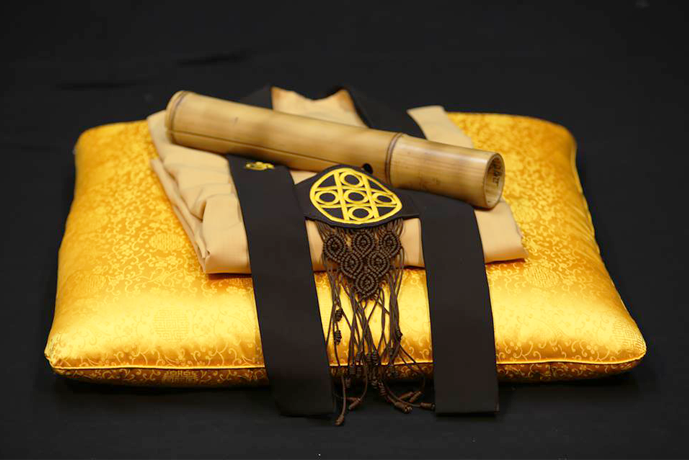
1. The Outlines of Jin-Gak Buddhist Order

Name of Order: Jin-Gak Buddhist Order
Founder of Jin-Gak Buddhist Order: Great Master Hoedang
The Doctrinal Buddha: Dharmakaya Mahavairocana Buddha
The Main Object for Worship: The Six-Syllables Mantra,
"Om Ma Ni Bhan Me Hum"
Foundation date: June 14, 1947
The Basic Sutras:
(1) Mahavairocana abhisambodhi vikurvita adhisthana-sutra
(2) Vajrasekhara-Sutra
(3) Boddhabhasita-mahayana-karanda vyuha ratnaraja-Sutra
(4) Bodhicitta Sastra
(5) Silhengron (The Teachings of the Great Master Hoedang)
2. Basic Tenet, Fundamental Principle,
Characteristics of Jin-Gak Buddhist Order
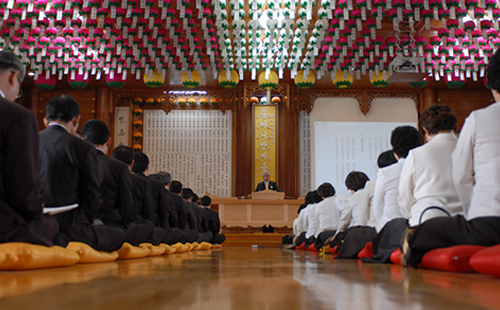
Basic Tenet
Jin-Gak Buddhist Order believes in the Dharmkaya-Mahavairocana Buddha, the oneness who is immanent in the world, which includes three stages of existence. Mahavairocana Buddha is the cosmic deployment of space in all directions as the doctrinal Buddha.
Jin-Gak Buddhist Order practices the Six-Syllable Mantra,
"Om Ma Ni Bhan Me Hum" as the main object of worship,
Which symbolizes SIMIN (the inner-most-bright mind) passed on throughout Buddhas and the Founder, and pursues the purification of the world from sins and the enlightenment of the truth of Dharmakaya as the final goal of religious practice.
Fundamental Principles
Jin-Gak Buddhist Order was founded on the theories of Esoteric Buddhism and based on the self-cultivation teachings of the founder, Great Master Hoedang who passed on the main tenets of Esoteric Buddhist Tradition, especially through Simin, the inner-most-bright mind. The Jin-Gak Buddhist Order is devoted to both the propagation of Buddhism and the salvation of mankind.
Characteristics of Jin-Gak Buddhist Order
The special characteristic of Jin-Gak Buddhist Order is that the "Buddhist priesthood along with the laity" who are in search of the "Highest Perfect Enlightenment" through the experience of the "Law of Cause and Effect" in this real life without renouncing the worldly life.
JIN-GAK SYMBOLIC IMAGES

Geumgang Ryun (Diamond Wheel)
Geumgang Ryun symbolizes the basic doctrine, the religious practice,and the self-discipline of the Jin-Gak Buddhist Order.
It also symbolizes wisdom and compassion, the two main virtues of the Mahavairocana Buddha,
the oneness immanet in the world,
The cosmic deployment in all directions, Thus it represents the five Buddhas and the Six syllable Mantra, Om Ma Ni Bhan Me Hum
The Six-Syllable Mantra OM MA NI BHAN ME HUM
"OM MA NI BHAN ME HUM", the Six-syllable Mantra is the main object for worship and practice for Jin-Gak Buddhsit Order. It symbolizes the inner most-bright mind of Mahavairocana Buddha, the Dharmakaya, doctrinal Buddha, Thus, even though one recites this mantra only once, one can achieve excellent merit, which is equal to the merit achieved from releasing living creature.
if one recites the mantra at least once within one's whole mind in accordance with the method of the meditation on Six syllable Mantra, one can be excused from the five cardinal sins. If one recites this mantra one hundred and eight times every day, one can be free from the three evil worlds namely hell, world of hungry-beings, and world of beasts. If one recites this mantra every day regularly, one can get the virtues such as the enlightment of wisdom, noble-mind, charming and clear voice. And all the teachings of Buddha will be understood, no diseases will be able to harm one's life, fright and fear will never aritse, no accidental death will take place, everything will turn out as one wishes, all sins will be excused, all kinds of evil spirits will disappear, abundant food and clothing will be possessed with the growing tendency of virtue. The lord of brilliant wisdom called Mahavidyaraja will be along with those wherever rebirth happens, one will never go to the three evil worlds eternally.
(Ref. From Avalokitesvara Six-Syllable Mantra Sutra)
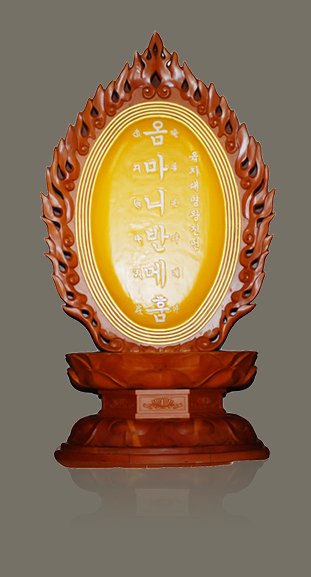
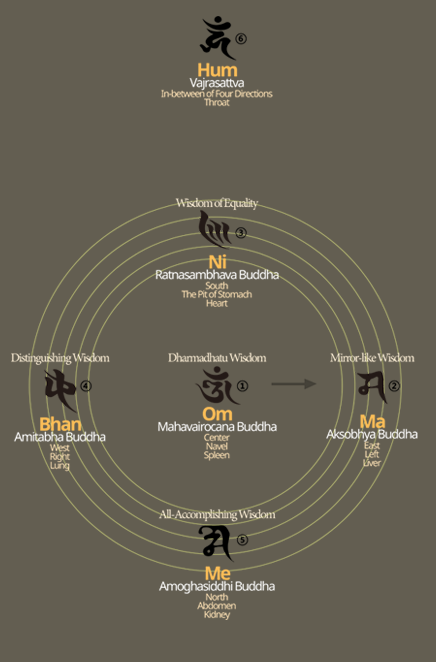
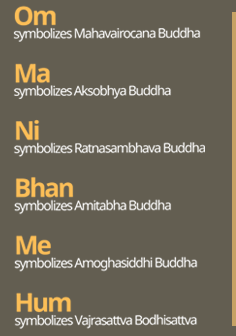
The Picture for
Six-Syllabled Meditation
Six-Syllabled Meditation
This mantra represents the inner natural bright mind of all kinds of Buddhas, Bodhisattvas and human beings. Moreover, this mantra includes the truth of universe as well as all kinds of dharmas of Buddhism. Therefore, all the sutras are based upon this mantra, which is the gateway (named Chongjimun) to the state of enlightenment.
HISTORY OF JIN-GAK
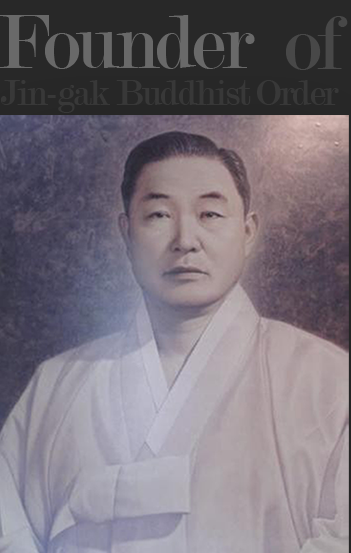
The Great Master, Hoedang (1902-1963)
The Great Master 'Hoedang', Kyu-Shang Sohn (his laity name), who dedicated his lfe for revival of Esoteric Buddhism, was the founder of Jin-Gak Buddhist Order. The Great Master was born on May 10, 1902 in Ulleung Island. When he was very young, he was of very sharp mind, and possessed precocious ability and far sightedness. When he was of ten years old, he had gone through a number of great classical literatures. At that same age he composed a significant poem.
"Mind makes all the things, Painted every picture on the pure mind."
"Mind makes all the things, Painted every picture on the pure mind."
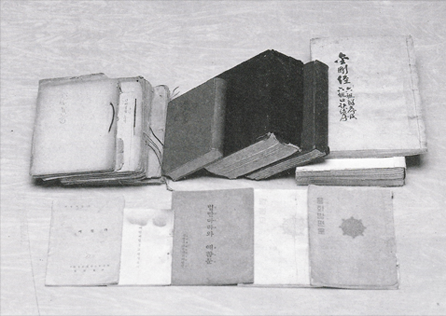
All the people, who had once come across him, noticed that he would someday be a great master. As time went on, he began to focus on Buddhism, making pilgrimage visits to important Buddhist sites in Korea and studying Buddhist texts day and night. In the fall of 1946, he founded a practical shelter in Nongrim Village in the Seongseo district of Taegu. Finally, on the 16th of May in 1947, he was enlightened on the true meaning of the Six syllables Mantra "OM MA NI BHAN ME HUM". After that, on the 14th of June of the same year , he announced his decision to establish a Buddhist Order by the name, "Jin-Gak Buddhist Order". He established a temple (Simindang), which he called Hee-rak Simindang in Namsandong district of Taegu. In the years following the Korean War, Great Master Hoedang went around to establish other Simindangs in many places throughout Korea including the main center, Milgak Simindang in Seoul, He dedicated his life serving for delivering people and encouraging patriotism among his fellow Koreans. He passed away peacfully at the age of 62 on the 16th of October in 1963 in Taegu, when the Jin-Gak Buddhist Order was only 17years old from its foundation. His final worlds to his followers were;
"In the past days, leaving cassock and almsbowl, now, passing down Simin, the inner-most-bright mind."
After his death, his teachings were accepted widely in Korea and many Koreans became his followers and have been becoming his followers.
He is Holy Honered One in Korean Buddhsim.
ESOTERIC BUDDHISM
Esoteric Buddhism is the essential teachings of Buddha
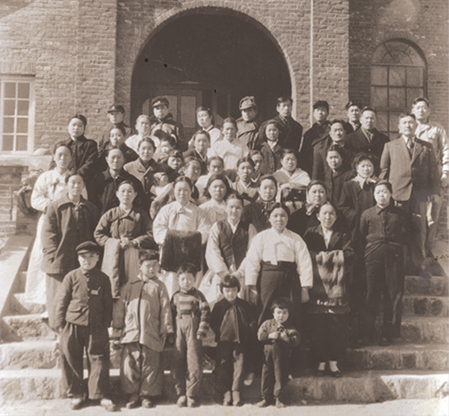
What is Esoteric Buddhsim?
If we say Theravada Buddhism is the Buddhism of Arhats and the Mahayana Buddhism is the Buddhism of bodhisattvas, the we can say that Esoteric Buddhism is the Buddhism of Buddha. Accordingly, what the Esoteric Buddhism consders as a supreme objective is neither the image of of ascetic like Arhats, nor the appearance of seeking truth like a bodhisattva who improves oneself for the purpose of benefiting others but the appearance of Buddha who practices Three Secrets. Hence what the Esoteric Buddhist practitioner has for his object is being the subject of Buddha nature and Buddha deeds through acting in concert Three Secrets, which both Buddha and human beings have in common.
Such form of Esoteric Buddhism flourished magnificently in ancient india from the middle of the 7th century to the beginning of the 8th century. It was spread to Tibet and China, and around the middle of the 8th century also introduced to Korea. WIth its combination with Six-syllable Mantra Faith introduced in Koryo Dynasty, it resulted in the form of characteristic Korean Esoteric Buddhism.
The History of Esoteric Buddhism in Korea
In Korea, Buddhism was introduced in the era of the Three Kingdoms (Koguryeo, Baekje, and Silla Kingdom). It was introduced to Koguryeo in 372 A.D., to Silla in 527 A.D. through the continent, and to Baekje in 384 A.D. through the sea. And before spreading to Silla a little bit faster it spread in Gaya (another Kingdom no included in the Three Kingdoms).
The early Buddhism gave preference for invoking blessing, which had an influence on the formation of the early Korean Esoteric Buddhism, so the monks' activities of the early Esoteric Buddhism were emphasized on the profit for the here world.
It has been heard as a kind of miracle that in the early 7th century Rev. Milbon cured the disease of people with chanting Medicine Buddha Sutra, and Rev. Myung-rang drove back the foreign invaders with practicing Munduru Secret Service, and Rev.Hyetong-hawsang made demon enemies surrender and healed diseases by practicing the ritual for averting calamities.
The Esoteric Buddhism having this aspect of invoking blessing in the period if the Three Kingdoms changed its characteristics as the 'Dharma lineage-oriented Esoteric Buddhism', which was the basic tenent of the medieval Esoteric Buddhism in India, was introduced in the beginning of the Unified Silla Dynasty. In the middle of the 8th century, Rev.Hyucho, Rev.Uirim and Rev.Bulgasaui got initiated in
the doctrine and the practice of MAhavairocana Sutra from Sunmuwoe Samjang, and Rev.Hyecho got initiated in the essence of Vajrasekhara-Sutra by Rev.Geumgangji Samjang and Rev.Bulgong-hawsang, then Rev.Hyeil and Rev.Ojin also inherited the doctrine of Mahavairocana Sutra and Vajrasekhara-Sutra from Rev. Hyegwa in the early 9th century.
 Then, in the early 10th century of Koryo Dynasty,
the fortune-searching Buddhism in the Three Kingdom Age and the 'Dharma lineage-oriented Esoteric Buddhism' which was the basic tenet of the Buddhsim in the Unified Silla Dynasty, had an enormous influence on the formation of Sin-In Buddhist Order and Chong-Ji Buddhist Order respectively. In addition, in the beginning of the 13th century Tibetan Buddhsim was introduced through Mongolia, and the Practical Method of Six-Syllable Mantra (Aum Ma Ni Bhan Me Hum) was formed at the lastest in the early of the 15th century which was derived from merging Six-syllable Mantra Faith with the doctrine of the medieval Esoteric Buddhsim in India.
Then, in the early 10th century of Koryo Dynasty,
the fortune-searching Buddhism in the Three Kingdom Age and the 'Dharma lineage-oriented Esoteric Buddhism' which was the basic tenet of the Buddhsim in the Unified Silla Dynasty, had an enormous influence on the formation of Sin-In Buddhist Order and Chong-Ji Buddhist Order respectively. In addition, in the beginning of the 13th century Tibetan Buddhsim was introduced through Mongolia, and the Practical Method of Six-Syllable Mantra (Aum Ma Ni Bhan Me Hum) was formed at the lastest in the early of the 15th century which was derived from merging Six-syllable Mantra Faith with the doctrine of the medieval Esoteric Buddhsim in India.

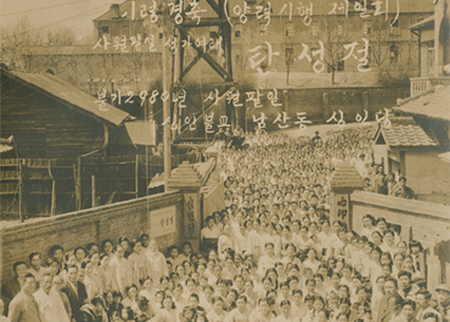
On the other hand, the Four Kinds of Altar-Worship of the Esoteric Buddhism were set up throughout the Koryo Dynasty, and a Buddhist Praying was observed continuously to conquer over the national disaster and to gain the peace of the people's livelihood in the same age. Among them were the Altar-Worship for averting calamities which originated in the curing of diseases from Rev.Hyetong and Rev.Milbon in the era of Three Kingdoms and the Altar-worship for exorcising demons which had its origin in Munduru Secret Service of Rev.Myungrang. In addition, the Altar-Worships for increasing good fortune and seeking love were introduced, these Four kinds of Altar-Worship of the Esoteric Buddhism were in company with the people and the nation.
Subsequently, these were retained under the name of Jung-Sin Buddhist Order and Chong-Nam Buddhist Order in the period of the Joseon Dynasty, but the only Dharma Streams of them were handed down being deprived of sectarian phases after the middle of the 15th century, while on the other, the Six-syllable Mantra Faith was developed to the extent of publishing its ritual collection, so the Practical Method of Six-Syllable Mantra was settled.
In the middle of the 16th century, on the basic of the Six-Syllable Mantra which contains the virtuous qualities achieved by Five Buddhas and all the Vajra-bodhisattvas, the practical bodhisattva path was emphasized through the completion of the Six Perfections and the and the salvation of all sentient beings.
Finally, Jin-Gak Buddhist Order was founded on the 14th of June, 1947 by the Great Master Hoedang who enlightened the cardinal principle of Six-Syllable Mantra Practice and advocated the restoration of Korean Esoteric Buddhism merging Six-Syllable Mantra with the doctrine of Esoteric Buddhism.
Here Modern Korean Esoteric Buddhism has advanced to an aspect uniting the idea of saving the world and the way of attaining Buddha-hood beyond the world, which has been upheld ever since the period of Three Kingdoms. So, it can be said that the establishment of Jin-Gak Buddhist Order by the Great Master Hoedang is the development of the Korean Esoteric Buddhism having characteristic for the purpose of achieving both worldly and non-worldly virtues.
ACTIVITIES
The Main Activities of Jin-Gak Buddhist Order
1. The Influence of the Order
1. Simindang And Followers
Jin-Gak Order has actively propagated to practice and awaken the truth of doctrinal Buddha as a representative Order of Korean Esoteric Buddhism.
Besides headquarters-Chonginwon in Seoul, 12 parishes are constructed in Seoul, Kyeonggi, Daejeon, Jeolla, Taegu, Gumi, Kyeongsan, Kyeongju, Pohang, Busan, Kyeongnam including the Jikhal parish which means direct control. There are over 120 Simindangs in the whole country, specially it enlists the overseas Simindangs in the Jikhal parish collectively, and accelerates the overseas missionary work to the American continents, China and southeastern Asia. So it has established a bridgehead for the globalization and internationalization of Jin-Gak culture.

2. The transparent administrative system and the enlargement of technical missionary territory
The characteristics of the Order's administration is a centralized system. On entering a localized era this system contains the necessities of getting the decentralized elements, but it was accepted to reform the modern Buddhism as an inevitable consequence, on giving consideration to the historical situation of Korean Buddhism. This centralized system made it possible that the presented pure offerings to Triple-Gems from Simindangs all over the country was used transparently for the sake of Korean Buddhism and the Order, and the management of Simindangs and believers was developed systematically. And the centralized running and the effective allocation of the Order's administration including personnel and financial affairs are regarded as the back bone of the existing growth of the Order.
Now, it is remarkable that the Order establishes and runs propagation facilities to professional territory such as a social education, welfare work, young generation, overseas propagation, reunification, environment, publication, press and so on. On a long-term basis, Jin-Gak Order aims at mapping out the advanced missionary plans through building up a new Infra and a network with the refined administration of the organization.


2. Training for Priest
The male and female priest of Jingak order are named as Jeong-sa and Jeon-su respecitvely, and commonly designated as Seuseung (the spiritual master in Korean). The training of priest is carried out by the Bureau of Education and Jin-Gak College, and Jin-Gak Buddhist Order has increased the opportunities for fostering priests by running the JGO scholarship after the opening of Uiduk University. Especially, it has researched and developed various programs for the lifetime education of Seuseung.
The Jin-Gak College opened to train priests in 1981 and from last year it has also started providing graduate course in Buddhist studies with the affiliation of Uiduk University.
Acarya and Simhak courses take charge of retraining the priest in the middle class, and KangGong-a plenary discourse is held for all the Seuseung to offer missionary information and to service high quality education twice a year.
3. Training for Laypeople
The keynote of the devotee training is to set up a unitary lifetime management system from children to adults. Jin-Gak Buddhist Order puts the discipline into practice in three way directions; first, running various activities of self-cultivation groups by age. second, operating positive means of propagation through home-visit Buddhist Service, and third, bringing Buddhist doctrine into peoples daily life through full family participation. And it enlarges the effect by constructing Simindang, Buddhist temple, in the inner city and by managing lively Buddhist Service system-Confession and Practice.
The followers are registered formally through the Buddhist Rituals for Initiation, then give their pledge that they practice Ten Precepts and devote themselves to actualize the Order's Basic Tenet of attaining Buddha-hood and purifying this world.
Jin-Gak Buddhist Order holds Esoteric Culture lecture to foster Buddhist and Esoteric feelings of followers and popularize the diverse Buddhist culture to them. Recently it has gained in public favor from the laity and the general public by opening lecture classes periodically for traditional lantern and Buddhist songs.


4. Ascetic practices
- Bulgong (Buddhist prayer and meditation) and the system of Buddhist Services
The unique characteristic of Jin-Gak's mission is to make followers do the self-cultivation of 'Timeless Bulgong, Placeless place) for themselves. The followers do practice meditation and offerings regularly everyday, do attend Buddhsit Service for the general public every Sunday called 'Jaseongil Bulgong', which stands for searching one's own nature, and do attend 'Suyo Bulgong' (suyo means Wednesday) every Wednesday.
Including these kinds of Bulgong-Buddhist prayer and meditation, the believers hold 'New Year Great Vow Bulgong' for 7 days. 'New Year 49days Bulgong' and 'Wolcho Bulgong' for 7 days at the beginning of a month, for the sake of family's peace and prosperity, the restoration of BUddhism and the peace in the country.
The offering practice is said to be a charity, which is given a positive character, and it is classified into three kinds of donations such as Dansi (offering to Buddha), Kyeongsi (offering to Dharma) and Jesi (offering to Sangha), so the believers do practice both 'with-form offering' and 'without-form offering' at the same time.
5. Hoedang Educational Foundation
Jin-Gak Buddhist Order has laid great emphasis on a social education from the great master HoeDang's life time and the early days of the Order, and it has enlarged the spirit with the establishment of the Hoedang Educational Foundation.
HoeDang Institute has shared its history with the Order's one and has made great strides with the Order's growth.
Under the Hoedang Educational Foundation, there are Simin middle & high school established in 1955 and Jinseon girls' middle & high school in 1977 and Uiduk University in 1996. In addition, there are over 30 educational facilities for children such as kindergartens and nursery schools.
In particular Uiduk university has settled down as the cradle of cultivating men of talent and developing Buddhist culture, and the Buddhist Department has systematic relations with the Esoteric Buddhist Culture Society and Silla Studies Research Institute as the affiliated organizations of the university.
Then Jin-Gak Buddhist Order has gained its ground as an educational-directional Buddhist Order both nominally and virtually by managing these educational facilities from infants to adults.


6. Jin-Gak Social Welfare Foundation
The followers of Jin-Gak Order practice the discipline of sharing what they have with others.
Jin-Gak Buddhist Order established a Social Welfare Foundation in 1998 to practice the doctrines of Buddha and the philosophy of the Order.
The true senses of the Order's welfare services are giving everyone a chavnce to participate in the social welfare programs and giving a shape to the charity ideology of Buddhism named of 'making a beneficial society'.
On the basis of present solid activities organizing volunteer groups, forming branch system and trust-operating welfare facilities, the Jin-Gak Social Welfare Foundation has been spreading three-dimensional social welfare work. And it does run high-quality programs such as international relief activities, social enlightenment campaigns and the education of welfare human resources through joining in the Non-government Organization Group.
Five Great Activites of Jin-Gak Welfare Foundation
1. Research and Publicity Work
- Planning the Social Welfare Work, Researching the Environment
of Regional Welfare, Developing various Welfare Programs
2. Organization Work
- Forming Branch system, Organizing the Social Welfare Volunteer Group
3. Trust-operating Work of Social Welfare Facilities
- Managing and Supporting Social Welfare Facilities
4. International Supports and Cooperation Work
- Running Free Health Clinic, JGO Scholarship, Computer Training
- Cooperating to improve Technology and Living Standard
5. The Work of Forming a Relationship with the Poor and Supporting the people
- Supporting the Minimum Living Standard of the Poor.
- Giving benefits to the Homeless Juvenile and Old People
JGO Srilanka
JGO Srilanka opened JGO Social Training Center in 1999. It has an Educational Hall, a Cultural Publicity Hall and a Residence Building. It is involved in several NGO activities. These include Computer Trainings, Language Courses for Korean and English, Vocational Training Programs, and also various screens with Korean culture. Through these kinds of activities JGO Srilanka has increased its role as a center of education and culture, which goes beyond the limits of a religion.
JGO Nepal
JGO Nepal set up a Free Health Clinic Center and has been giving medical services everyday. It runs coaching classes and computer basic training for school students, also emphases in practicing meditation and chanting the Six Syllable Mantra. The Youth Group organized by JGO Nepal has worked in the wild field of social service systematically. JGO Nepal also created a scholarship fund under the name of JGO Scholarship and has conferred benefits for many students. It puts great emphasis on the activities of the Youth Group, which will play the leading part in its future society through providing various training programs to the young generation.



7. International Relationship
Under the spirit of the times named Participation, Harmony and Dedication, Jin-Gak Order has actively participated in Korean Conference on Religion and Peace(KCRP), World Conference on Religion and Peace(WCRP), and World Fellowship of Buddhists(WFB) to advance the cooperative activities among religions and to open the era of international religious cooperation.
As a vice-chairman of the Association of Korean Buddhist Orders, Jin-Gak Order also has contributed to Buddhist cultural exchanges, friendship and nongovernmental interchanges in the northeastern Asia through taking a part in Korea-China-Japan Conference for Buddhist Relationship and Korea-Japan Conference for Buddhist Cultural Relationship, and pushed its communal cooperation with Buddhist solidarity, and concentrated its energy on the stability and peace of the world.
Jin-Gak Order has been particularly extending the range of exchange to Famen Temple in Xi'an China, and to Tabo Gompa in the North of India. Famen Temple is a representative temple of Chinese Esoteric Buddhism and as a great sanctum on which the Imperial of the Tang age fixed its affection. Tabo Gompa, which is situated in the middle of the introduction of Mahayana Buddhism and Esoteric Buddhism, is a meaningful temple, over 1,000 years old, giving the concrete expression of Vajradhatu-mandala as it is.
Jin-Gak Order, which has been considering the Thirty-seven heads in the Vajradhatu-mandala as the principal tenet, goes forward erecting its natural character step by step as a restoration order of Korean Esoteric Buddhism by jumping over the limits of time and space through the scientific exchanges and Buddhist services with these historic and meaningful temples.
PARISHES
Location for Jin-Gak Buddhist Parishes

Seoul
Province

Daegu
Province

Busan
Province

Daejen
Province

Jeolla
Province

Kyeongju
Province

Pohang
Province

+82 2-913-0751
Copyright ⓒ 2016. Jin-Gak Buddhist Order. All Rights Reserved.